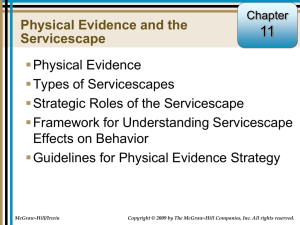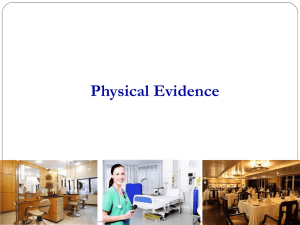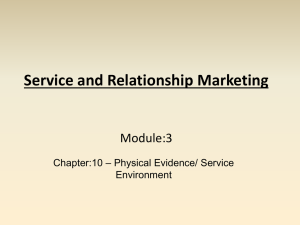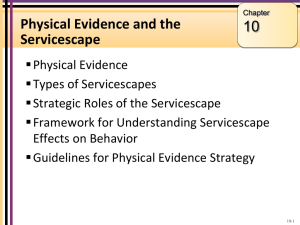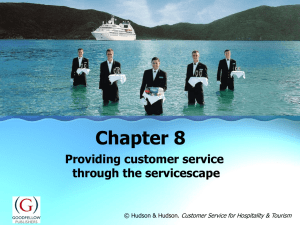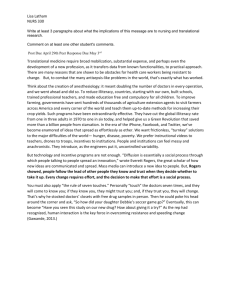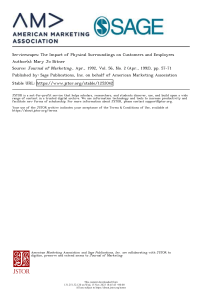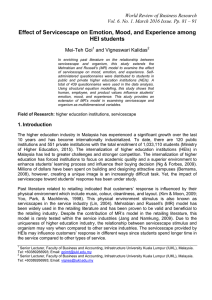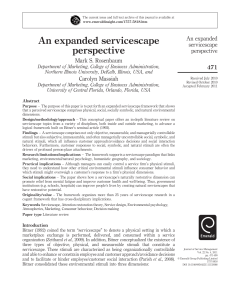Exceeded (WOW factor)
advertisement
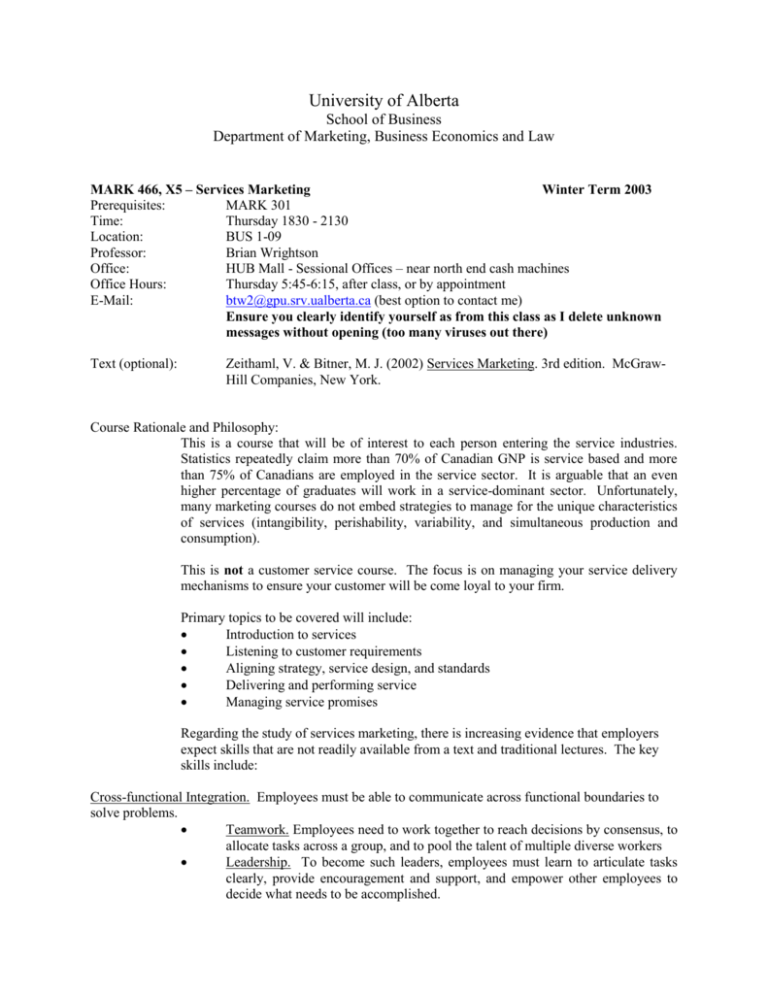
University of Alberta School of Business Department of Marketing, Business Economics and Law MARK 466, X5 – Services Marketing Winter Term 2003 Prerequisites: MARK 301 Time: Thursday 1830 - 2130 Location: BUS 1-09 Professor: Brian Wrightson Office: HUB Mall - Sessional Offices – near north end cash machines Office Hours: Thursday 5:45-6:15, after class, or by appointment E-Mail: btw2@gpu.srv.ualberta.ca (best option to contact me) Ensure you clearly identify yourself as from this class as I delete unknown messages without opening (too many viruses out there) Text (optional): Zeithaml, V. & Bitner, M. J. (2002) Services Marketing. 3rd edition. McGrawHill Companies, New York. Course Rationale and Philosophy: This is a course that will be of interest to each person entering the service industries. Statistics repeatedly claim more than 70% of Canadian GNP is service based and more than 75% of Canadians are employed in the service sector. It is arguable that an even higher percentage of graduates will work in a service-dominant sector. Unfortunately, many marketing courses do not embed strategies to manage for the unique characteristics of services (intangibility, perishability, variability, and simultaneous production and consumption). This is not a customer service course. The focus is on managing your service delivery mechanisms to ensure your customer will be come loyal to your firm. Primary topics to be covered will include: Introduction to services Listening to customer requirements Aligning strategy, service design, and standards Delivering and performing service Managing service promises Regarding the study of services marketing, there is increasing evidence that employers expect skills that are not readily available from a text and traditional lectures. The key skills include: Cross-functional Integration. Employees must be able to communicate across functional boundaries to solve problems. Teamwork. Employees need to work together to reach decisions by consensus, to allocate tasks across a group, and to pool the talent of multiple diverse workers Leadership. To become such leaders, employees must learn to articulate tasks clearly, provide encouragement and support, and empower other employees to decide what needs to be accomplished. Answers to FAQ’s Oral and Written Communication Skills. Two-thirds of all employers in a recent AACSB survey claim that business education places too little emphasis on key aspects of management, particularly communication skills (Porter and McKibbin 1988). Listening Skills. Listening includes the ability to hear and comprehend disparate views that arise out of diversity in the workplace, cross-functional integration, globalization and other forces. Critical Thinking and Problem Solving. Employees must have the capability to digest vast amounts of information, cull it for relevance to their job, and then translate it into useful knowledge for themselves and others in the organization. They especially need the skills to detect and articulate problems when they are unstructured. Employees must also be able to assemble and synthesize information from unrelated sources to solve problems Papers double-spaced, typed, 12 point font Stapled in the top left-hand corner – please, no covers The standard measure will be “as your business client, would I be impressed?” The majority of assignments are research based. References and works cited must be acknowledged as it makes your work more credible. If you do not agree with the thesis say so - and reason why – learn from those who are published. Think critically. You will be required to be an independent learner. Length is not a gauge of a well-written document. Concise yet clear and complete is what industry demands. Yes - a penalty may be assessed I seldom read appendices. Tables and charts must be discussed within your text Organize and present your thesis. I appreciate organization including appropriate headings to draw my attention to key topics and points Use a single writer for group projects. This person holds a critical role, as you must write in one “voice” while editing redundancies, inconsistencies, and gaps. Late submissions must be pre-approved by the professor (penalty as high as 100% per day). Talk to me. Think and plan strategically not tactically. Remember I know much of the content in the course but I am not sure about you. Tell me you know – I cannot assume you do until you give evidence. I want to be able to assess what you feel to be important and relevant to the topic. You may run a draft of any assignment past me IN ADVANCE (defined as more than 72 hours before the due date). You must leave a contact phone number and availability, as I will want to give you direct feedback. It has been said, “Conventional wisdom saves one from the difficult task of thinking.” Your challenge is to determine what is important. I will give you guidelines but I will not give you a “cookie-cutter” template for assignments. Seldom is there a perfect answer and often there are multiple approaches that will be equally successful. Evaluation: Exploring Basic Services Concepts 30% February 13 Choice for second assignment of: 30% Interactive Electronic Services Project or Servicescape as a Competitive Advantage March 20 Final examination April 3 (in class) 40% Evaluation Criteria: Exploring Basic Services Concepts The exercise will take place in the fifth week. Virtually all students have experience with Doctors, and it is a service that can be delivered in significantly different ways. Although the description of this activity is based on health care, many other services would work equally well (e.g., banks, colleges, automobile dealerships, and so on). You will be asked in week two to select five or six industries (I may reserve veto power to ensure that we get a representative selection) and to select one industry for yourself (you should work in pairs). A further division of participants will take place within each industry into teams of somewhat equal size. Within each industry, there are competitors who approach the market differently. For instance doctors practice differently; traditional doctors (with regular office practices) with traditional patients; medi-centre doctors (affectionately known as “doc in the boxes”); and doctors by phone or Web. For each of the teams the task is the same: Each industry (say for doctors the teams are the traditional, immediate care, and phone/Web segments) must meet and determine the core benefit model for their service sector. (In-class week two) Each team will then be responsible for evaluating their specific industry sector based on fundamental concepts of services marketing such as: o Tangibility spectrum o Customer’s evaluation of services o Zone of tolerance Just ensure that each industry chooses the same criteria A paper (60%) will be submitted by each team/subset of each industry for grading that documents. This paper will provide their analysis of their industry approach from both a theoretical and practical perspective. The paper will be 3 to 4 pages. The teams within each industry will gather in week six to present (40%) to the class their findings. Be sure to apply theoretical concepts when analyzing service providers in their everyday environment. Your industry sector teams need not work together as long as you are using the same fundamental concepts although you may want representatives to gather to discuss you final presentations. The presentations should be about twenty to twenty-five minutes. Please ensure that you involve the class in your presentation. Questions might be directed to the whole class by a group studying the medical industry might include: What do you think of the doctors by phone/Web service? Would you use this service? If so, under what circumstances? What might the differences be in the training and skills for example, that the doctors by phone/Web might need versus traditional doctors? I would challenge you to be creative with your presentation as part of your mark will be dependent of how you deliver the concepts/comparisons/contrast to the rest Interactive Electronic Services Project Choose ONE internet service provider such as an auction house or airline, a financial or tourism based business, a library or medical information source, or a more conventional product purveyor. Describe the service in detail and compare the electronic service to the brick and mortar or face-to-face equivalent. Using conventional service principals as a base point, critique whether this site translates best practice to the technological interface. Focus not just on the text, video, audio, and graphics (although we cannot totally ignore their contribution to the experience) but also on the service delivered. Integrate course concepts whenever possible. The inclusion of outside references is mandatory. Part two of this discussion must outline improvements that could be integrated into this site to improve their service to the customer. In essence, provide a “how-to” manual outlining how brick and mortar companies can take their distinctive experience to the WWW. To assist you in starting on this assignment the following site references may serve and a springboard to this project. For instance, Rayport and Jaworski in Introduction to Ecommerce (2001) recommend Seven C’s (Content, Context, Community, Customization, Communication, Connection, and Commerce) as a basis for a well designed website. The following search criteria may serve as a springboard to reference materials when searching the WWW: e-Business · Electronic Commerce · Electronic Markets Customer Relationship Management · Supply Chain Management · Web Marketing You might also visit: http://www.unisys.com/execmag/framesets/e-commerce-ts.htm This paper should be no more than eight pages. OR Servicescape as a Competitive Advantage The objective of this exercise is to compare and contrast two local service providers to demonstrate the differences in competitive formulas of two service firms who are providing the same core benefit. (U of A Library and Edmonton Public Library, Earls and Tim Hortons, Super 8 and Jasper Park Lodge, Greyhound and Red Arrow, and so on). You should consider the following questions. For each provider, what is done well in this servicescape? Elaborate and point out specific examples. For each provider, what aspects of this servicescape have a positive influence on customer perceptions of the overall service experience? Similarly, what aspects of this servicescape do not necessarily have a positive influence on customer perceptions of the overall service experience? Explain. Which of the following characteristics (color, lighting, shapes, sound, smell) in each servicescape influences the customer’s experience? Explain. What other aspects (besides the servicescape) of physical evidence are present? How does each provider (fast food and full-service) use the servicescape as a differentiator? in their positioning strategy? to appeal to their target segment(s)? to facilitate service delivery? How does each provider (fast food and full-service) use physical evidence (other than the servicescape) as a differentiator? to enhance the customer’s experience? To facilitate service delivery? What suggestions would you make to improve the servicescape and other physical evidence for each provider (fast food and full-service)? This paper should be no more than eight pages Final examination April 11, 2003 Final Examination – Based on all lecture and course materials. This examination may include multiple choice, short answer, and/or essay questions. The format will be determined and announced closer to examination day. Marking: To adapt the Zone of Tolerance Model from Services Marketing, my enduring intensifiers or derived service intensifiers are the content as discussed in class and from your various readings. An 8 indicates that you have covered the topic leaving no question that you are familiar with the material. Those who wish to exceed that level will add “that something extra” and they will be rewarded with a 9 or 10 Content and expectations Exceeded (WOW factor) Desired level Zone of tolerance Adequate level Below expectations Marks allotted 9 or 10 8 6 or 7 5 0 to 4 A top mark in both assignments and examinations will be reserved for those who demonstrate their ability to integrate theory with the practical. One should demonstrate an understanding of the theoretical base then demonstrate whether/how the theory fits with reality. This demonstrates a higher level of learning and industry demands thinking and problem solving skills. Grade Disputes: I will always be available to discuss with students your concerns about grading and marketing but I will not entertain such discussions on the day of an exam or paper is returned. I will be pleased to do so during office hours or at a time that is mutually agreeable. In case of dispute, please initiate discussions with me. Your recourse is then the Department Chair. Should you still be unsatisfied, the matter may be taken to the Assistant Dean, Undergraduate. Academic Integrity: I will be giving two evaluations – one in services marketing and the other in honesty. I hope you will pass them both. But if you must fail one, then fail services marketing. There are many good people in the world that cannot pass services marketing but there are no good people in the world that cannot pass the test of honesty. Students who commit any act of plagiarism, cheating, or misrepresentation in this course will be penalized in accordance with the University Regulations Section 26. Plagiarism and cheating can include: Any use of the words and ideas of any other person in an academic assignment or project without adequate acknowledgement constitutes plagiarism. Any misrepresentation of any fact to gain academic advantage is an offence under the Code of Student Behaviour. Any submission of the work of another person represented to be your work is an offence. Any unauthorized collaboration in an examination, assignment, paper, or project. Students should collaborate in the preparation of course work but it is required that your work on exams must be unique and individual and of your own doing. Project work is, of course, highly collaborative. Penalties can range as high as expulsion from the University. The full text of the Code of Student Behaviour can be found in the University of Alberta Calendar, Section 26 SCHEDULE January 9 Introduction Chapter 1 Chapter 18 Introduction to services The Integrated Gaps Model January 16 Chapter 2 Consumer behaviour January 23 Chapter 3 Chapter 4 Customer expectations of service Customer perceptions of service January 30 Chapter 5 Understanding customer expectations February 6 Chapter 6 Chapter 7 Building customer relationships Service recovery February 13 Basic concepts presentations February 27 Chapter 17 (no text) The financial and economic effect of services E-Service March 6 Chapter 8 Chapter 9 Service development and design Customer-defined service standards March 13 Chapter 10 Chapter 11 Physical evidence and servicescapes Employees’ roles in service delivery March 20 Chapter 12 Chapter 13 Chapter 14 Customers’ roles in service delivery Delivering services Managing supply and demand March 27 Chapter 15 Chapter 16 Integrating services marketing communications Pricing of services April 3 Final Examination All Chapters
